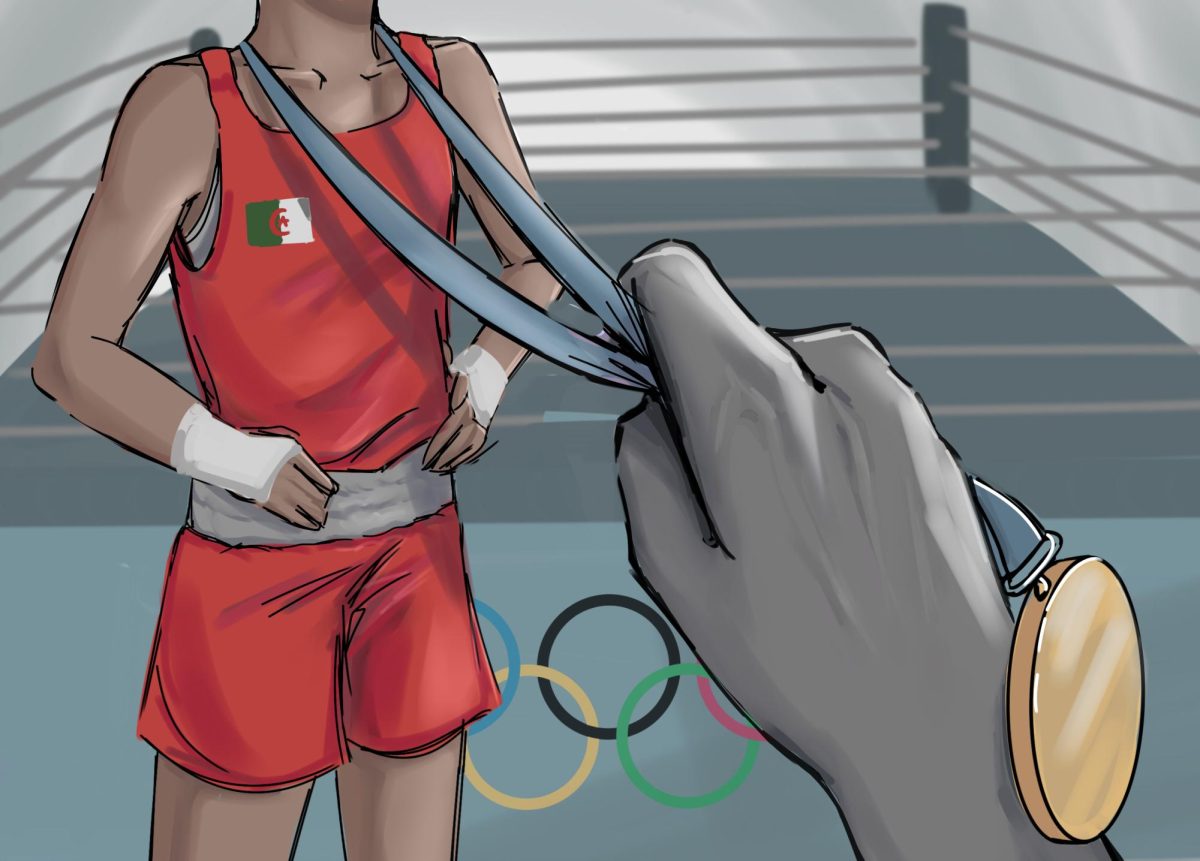The sharp clang of the boxing bell reverberates through the stadium, signaling the start of the match. Two figures, one clad in red, the other in blue, circle each other with calculated precision. In an instant, the woman in red, Algerian boxer Imane Khelif, strikes—once, twice, thrice. In under a minute, she secures her spot in the 2024 Olympic boxing finals. Yet instead of being celebrated for her triumph, Khelif finds herself at the heart of a controversy over her gender identity.
The dispute first arose after Italian boxer Angela Carini withdrew from her match against Khelif 46 seconds in. She then fell to her knees crying and refused to shake Khelif’s hand, later telling reporters she “had never felt a punch like this.” Olympics watcher Tanvi Sivakumar (11) comments on the spread of misinformation following Carini’s statements.
“The fact that Angela Carini’s statement after her loss made so many people doubt Imane showed to me how quickly wrong information can be spread,” Tanvi said. “I think the match being on the big Olympic stage also added to the controversy.”
The notion of Khelif being a transgender athlete initially developed after the International Boxing Association disqualified her from last year’s world championship. Taiwanese boxer Lin Yu-Ting was disqualified alongside Khelif, with the IBA claiming that the two athletes did not pass undisclosed gender-eligibility tests. This fueled rumors that both were transgender women.
Gender eligibility tests have been historically problematic, with methods in the 1960s requiring female athletes to strip in front of a panel of doctors to prove their sex. Due to the IBA’s continued use of inaccurate gender-eligibility tests that disproportionately and baselessly eliminate female athletes of color, the International Olympic Committee later banned the IBA from overseeing the Olympics, citing the association’s lack of transparency and biased governance.
However, the elimination of transgender women from athletics is no anomaly. Gender controversies in the Olympics date back to 2021, when Laurel Hubbard made history by becoming the first transgender athlete to compete in the Olympics. While her participation marked a significant milestone for transgender athletes, it also sparked debates surrounding the IOC’s policies permitting transgender women to compete in women’s athletics. Having seen both sides of the argument, lacrosse player Sam Parupudi (12) contextualized the recent criticism towards Khelif.
“I think it was something deeper,” Sam said. “It was the hatred within the community as opposed to just about her. She’s become a point of contest for people who want to talk about being transgender as an issue. It gives them an outlet for that.”
Amidst the many perspectives on transgender participation, one major question remains central: how is “fairness” in athletics defined?
Athletics have been historically split into categories based on age and sex to maintain equal competition. While separating athletes based on these traits helps minimize unfair physical advantages, special cases continue to arise. For example, 28-time Olympic medalist Michael Phelps has abnormal lactic acid levels that offer him a physical advantage over other swimmers. Cyclist Miguel Induráin’s large lung capacity of 7.8 liters, which surpasses the normal lung capacity of 6 liters, also allows him to perform better than his opponents.
Rather than receiving criticism for these physiological advantages, both athletes have largely been lauded for their incredible athleticism, but acceptance of physical advantages diminishes when the focus shifts to transgender participation in athletics.
In June 2022, the World’s swimming governing body banned the participation of transgender athletes in women’s swimming events, instead only allowing athletes who transitioned before the age of 12 to compete. Track and field soon followed suit in March 2023, adopting the same ban as swimming did for transgender athletes in international competition.
The House of Representatives also passed legislation in 2023 prohibiting transgender women from competing in women’s athletic programs. Although the Senate has not approved the bill, it reflects the continuing stigma surrounding transgender athletes, which similarly affected this year’s Olympic games.
As the debate over transgender participation in sports persists, athletes like Khelif and Lin Yuting navigate significant challenges posed by ongoing controversies. The evolving discussions about transgender athletes highlight the ongoing search for balance between fair competition and inclusivity. Amid these complexities, Sam celebrates Khelif’s resilience.
“I’m super proud because I know this Olympics has been 10 times as hard for her,” Sam said. “She had to go through this physical turmoil of being a boxer on top of the mental turmoil of people constantly questioning your identity, questioning where you came from, questioning if you’re even eligible. So I very much applaud her for the victory.”




![LALC Vice President of External Affairs Raeanne Li (11) explains the International Phonetic Alphabet to attendees. "We decided to have more fun topics this year instead of just talking about the same things every year so our older members can also [enjoy],” Raeanne said.](https://harkeraquila.com/wp-content/uploads/2025/10/DSC_4627-1200x795.jpg)


















![“[Building nerf blasters] became this outlet of creativity for me that hasn't been matched by anything else. The process [of] making a build complete to your desire is such a painstakingly difficult process, but I've had to learn from [the skills needed from] soldering to proper painting. There's so many different options for everything, if you think about it, it exists. The best part is [that] if it doesn't exist, you can build it yourself," Ishaan Parate said.](https://harkeraquila.com/wp-content/uploads/2022/08/DSC_8149-900x604.jpg)




![“When I came into high school, I was ready to be a follower. But DECA was a game changer for me. It helped me overcome my fear of public speaking, and it's played such a major role in who I've become today. To be able to successfully lead a chapter of 150 students, an officer team and be one of the upperclassmen I once really admired is something I'm [really] proud of,” Anvitha Tummala ('21) said.](https://harkeraquila.com/wp-content/uploads/2021/07/Screen-Shot-2021-07-25-at-9.50.05-AM-900x594.png)







![“I think getting up in the morning and having a sense of purpose [is exciting]. I think without a certain amount of drive, life is kind of obsolete and mundane, and I think having that every single day is what makes each day unique and kind of makes life exciting,” Neymika Jain (12) said.](https://harkeraquila.com/wp-content/uploads/2017/06/Screen-Shot-2017-06-03-at-4.54.16-PM.png)








![“My slogan is ‘slow feet, don’t eat, and I’m hungry.’ You need to run fast to get where you are–you aren't going to get those championships if you aren't fast,” Angel Cervantes (12) said. “I want to do well in school on my tests and in track and win championships for my team. I live by that, [and] I can do that anywhere: in the classroom or on the field.”](https://harkeraquila.com/wp-content/uploads/2018/06/DSC5146-900x601.jpg)
![“[Volleyball has] taught me how to fall correctly, and another thing it taught is that you don’t have to be the best at something to be good at it. If you just hit the ball in a smart way, then it still scores points and you’re good at it. You could be a background player and still make a much bigger impact on the team than you would think,” Anya Gert (’20) said.](https://harkeraquila.com/wp-content/uploads/2020/06/AnnaGert_JinTuan_HoHPhotoEdited-600x900.jpeg)

![“I'm not nearly there yet, but [my confidence has] definitely been getting better since I was pretty shy and timid coming into Harker my freshman year. I know that there's a lot of people that are really confident in what they do, and I really admire them. Everyone's so driven and that has really pushed me to kind of try to find my own place in high school and be more confident,” Alyssa Huang (’20) said.](https://harkeraquila.com/wp-content/uploads/2020/06/AlyssaHuang_EmilyChen_HoHPhoto-900x749.jpeg)





